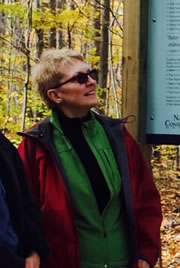Betty Henderson and The Elsa Wild Animal Appeal of Canada
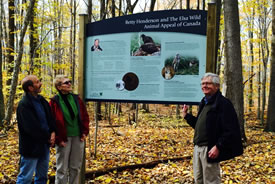
Judith Eger, Jack Bateman and Robert Hester of the ELSA Wild Canada Appeal (Photo by NCC)
This fall, the Nature Conservancy of Canada (NCC) unveiled a commemorative sign honouring Doreen Elizabeth (Betty) Henderson’s contributions to conservation in Canada. The sign was erected in NCC’s Norfolk Forests and Long Point Wetlands project area, located in Norfolk County, Ontario. Betty founded The Elsa Wild Animal Appeal of Canada (ELSA Canada) in 1971 and pursued her passion for wildlife conservation until her death in 2009.
Doreen Elizabeth (Betty) Henderson was born in Toronto on December 22, 1925. She attended Victoria College at the University of Toronto where she nurtured her love of the English language, English history, music and French. She taught in England in the years after the Second World War. When she returned to Canada, she embarked on a long career as a high school teacher in Toronto.
Betty Henderson's founding of The Elsa Wild Animal Appeal of Canada (ELSA Canada) was the result of a chance meeting in Kenya between Betty and Joy Adamson, the naturalist and world renowned author of Born Free, the story that chronicled Joy’s experience with Elsa the lioness. Joy had founded Elsa Wild Animal Appeals in several countries around the world. Over the course of their time together, Joy convinced Betty to lead an Elsa Wild Animal Appeal in Canada.
A woman of firm convictions, Betty became a champion of wildlife in Canada and determined in her pursuit of the goals of wildlife conservation.
Betty Henderson was the President of ELSA Canada from its founding until her death on May 14, 2009. Under her leadership, the organization raised funds in Canada and directed these funds to projects supporting the conservation and rehabilitation of Canadian wildlife. While there are countless examples of Betty's contributions to Canadian conservation, I've outlined a few examples of Betty & ELSA Canada’s successes below.
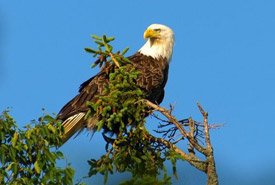
Bald eagle (Photo by Keith Mombour)
The return of bald eagles to the north shore of Lake Erie
Prior to European settlement, bald eagles were a common sight in the Great Lakes basin. But by the 1970s, the few remaining eagle pairs on the Lake Erie shore produced no young.
Thankfully, significant reductions in the use of toxic chemical pesticides around the Great Lakes by the early 1980s meant that recovery of the bald eagle population in the area was possible.
From 1983 to 1987, ELSA Canada funded a bald eagle reintroduction program carried out jointly by the Canadian Wildlife Service, Environment Canada and the Ontario Ministry of Natural Resources. Young, flightless bald eagles were transferred from northwestern Ontario to a rearing and release site at Long Point. The transplanted birds were kept in an artificial nest structure until they were able to be released. During the five-year project, 32 bald eagles were transferred to Long Point.
The southern Ontario bald eagle population has recovered considerably from the extremely low numbers of the 1970s. In 2011, 69 eaglets were known to have successfully developed and left their nests in southern Ontario, the product of 57 active nests. Of these, the north shore of Lake Erie produced 18 eaglets from 17 nests of known outcome.
The return of the wild turkey to Ontario
Loss of habitat and market hunting led to the extirpation of wild turkeys in Ontario early in the 1900s. These birds had formerly been present in southern Ontario, mainly in the southwestern part of the province. In the 1980s, an Ontario Wild Turkey Reintroduction Program was begun, led by the Ontario Federation of Anglers and Hunters, the Federation of Ontario Naturalists and the Ontario Ministry of Natural Resources.
ELSA Canada assisted in the funding of this project. The program was a success and wild turkeys are now a common sight in southern Ontario.
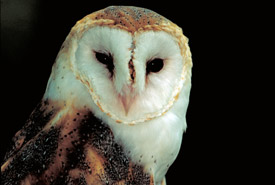
Barn owl (Photo by Dr. Thomas G. Barnes/University of Kentucky)
Helping injured and orphaned owls
The Owl Foundation has been helping wild Canadian owls that have been injured or orphaned since the 1970s. Founded by Larry and Kay McKeever, and located in Vineland Ontario on the Niagara Peninsula, The Owl Foundation helps owls that are injured, diseased or starving back to health so they can be released. Orphaned owl chicks are raised at The Owl Foundation and released when they are able to survive on their own.
ELSA Canada was an early supporter of The Owl Foundation.
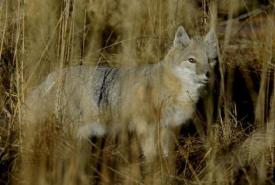
Swift fox (Photo by Karol Dabbs)
The swift fox and the burrowing owl
Over the years, ELSA Canada provided support to both the Cochrane Ecological Institute in Alberta for their work to restore the swift fox in Canada and to Nature Saskatchewan for their work to restore the burrowing owl.
The swift fox was no longer present in Canada when the Cochrane Ecological Institute began its work in the 1970s. The status of the species was upgraded from extirpated (locally extinct) to endangered in 1998. This was the first successful small canid reintroduction in Canada.
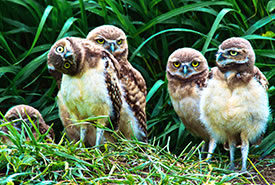
Burrowing owls (Photo by Don Dabbs)
The burrowing owl is a species that nests in burrows in mixed grasslands on the Canadian prairie. It was once common in summer but, due to habitat loss, the population has been greatly reduced. Through habitat protection, enhancement and restoration, Nature Saskatchewan is increasing the Canadian burrowing owl population.
A lasting natural legacy
Although Betty is no longer with, us her legacy lives on in her work throughout Canada. We only hope that others continue to share the same passion Betty did for the environment.
NCC is proud to celebrate and remember Betty’s legacy with the dedication in Norfolk.
“Betty’s life was yet another example of one single dedicated ordinary person leaving a more than ordinary legacy.” ~ Robert Bateman
Written by Judith Eger (president), Jack Bateman (vice-president) and Robert Hester (secretary-treasurer) — members of the ELSA Canada Wild Animal Appeal Board of Directors and long-time friends of Elizabeth Henderson. ELSA Canada was founded in 1971 and supports Canadian endangered wildlife species through research and rehabilitation projects.

